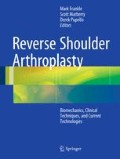Abstract
Reverse shoulder arthroplasty is proposed when glenohumeral osteoarthritis is associated with rotator cuff deficiency. The non-anatomical design of the reverse prosthesis constrains the articular surfaces and displaces medially the joint rotation center. The gain in stability and muscle moment arms is counterbalanced by impingements that reduce the shoulder mobility. From a biomechanical perspective, reverse shoulder prostheses are thus deeply different from anatomical shoulder prostheses and healthy non-prosthetic shoulders. Computer modeling was used to study the potential of reverse shoulder arthroplasty and reduces its current limitations. In the first step, numerical simulations were used to analyze key biomechanical characteristics of reverse shoulder arthroplasty, by comparison with anatomical shoulder arthroplasty: muscle moment arms, joint reaction force, and contact patterns. In the second step, several design parameters of the reverse prosthesis were evaluated, such as the lateralization of the glenosphere. Computer modeling can be an effective tool to evaluate and improve joint prostheses, especially the reverse prosthesis, because of its non-anatomical design. Today, patient-specific computer modeling might be associated with three-dimensional surgical planning, to help explore the potential indications for reverse shoulder arthroplasty.
Access this chapter
Tax calculation will be finalised at checkout
Purchases are for personal use only
References
Terrier A, Reist A, Vogel A, Farron A. Effect of supraspinatus deficiency on humerus translation and glenohumeral contact force during abduction. Clin Biomech. 2007;22(6):645–51.
Terrier A, Vogel A, Capezzali M, Farron A. An algorithm to allow humerus translation in the indeterminate problem of shoulder abduction. Med Eng Phys. 2008;30(6):710–6.
Terrier A, Larrea X, Malfroy Camine V, Pioletti DP, Farron A. Importance of the subscapularis muscle after total shoulder arthroplasty. Clin Biomech (Bristol, Avon). 2013.
Terrier A, Scheuber P, Pioletti DP, Farron A. Activities of daily living with reverse prostheses: importance of scapular compensation for functional mobility of the shoulder. J Shoulder Elbow Surg. 2013.
Terrier A, Brighenti V, Pioletti DP, Farron A. Importance of polyethylene thickness in total shoulder arthroplasty: a finite element analysis. Clin Biomech (Bristol, Avon). 2012.
Terrier A, Aeberhard M, Michellod Y, Mullhaupt P, Gillet D, Farron A, et al. A musculoskeletal shoulder model based on pseudo-inverse and null-space optimization. Med Eng Phys. 2010;32(9):1050–6.
Terrier A, Ramondetti S, Merlini F, Pioletti DD, Farron A. Biomechanical consequences of humeral component malpositioning after anatomical total shoulder arthroplasty. J Shoulder Elbow Surg. 2010;19(8):1184–90.
Terrier A, Merlini F, Pioletti DP, Farron A. Total shoulder arthroplasty: downward inclination of the glenoid component to balance supraspinatus deficiency. J Shoulder Elbow Surg. 2009;18(3):360–5.
Terrier A, Merlini F, Pioletti DP, Farron A. Comparison of polyethylene wear in anatomical and reversed shoulder prostheses. J Bone Joint Surg Br. 2009;91(7):977–82.
Terrier A, Reist A, Merlini F, Farron A. Simulated joint and muscle forces in reversed and anatomic shoulder prostheses. J Bone Joint Surg Br. 2008;90(6):751–6.
Engelhardt C, Malfroy Camine V, Ingram D, Mullhaupt P, Farron A, Pioletti PD, et al. Comparison of an EMG-based and a stress-based method to predict shoulder muscle forces. Comput Methods Biomech Biomed Eng. 2014 (Accepted for publication).
An KN, Browne AO, Korinek S, Tanaka S, Morrey BF. Three-dimensional kinematics of glenohumeral elevation. J Orthop Res. 1991;9(1):143–9.
McClure PW, Michener LA, Sennett BJ, Karduna AR. Direct 3-dimensional measurement of scapular kinematics during dynamic movements in vivo. J Shoulder Elbow Surg. 2001;10(3):269–77.
Johnson GR, Spalding D, Nowitzke A, Bogduk N. Modelling the muscles of the scapula morphometric and coordinate data and functional implications. J Biomech. 1996;29(8):1039–51.
Kronberg M, Nemeth G, Brostrom LA. Muscle activity and coordination in the normal shoulder. An electromyographic study. Clin Orthop Relat Res. 1990;257:76–85.
van der Helm FC. Analysis of the kinematic and dynamic behavior of the shoulder mechanism. J Biomech. 1994;27(5):527–50.
Graichen H, Stammberger T, Bonel H, Karl-Hans E, Reiser M, Eckstein F. Glenohumeral translation during active and passive elevation of the shoulder—a 3D open-MRI study. J Biomech. 2000;33(5):609–13.
Kelkar R, Wang VM, Flatow EL, Newton PM, Ateshian GA, Bigliani LU, et al. Glenohumeral mechanics: a study of articular geometry, contact, and kinematics. J Shoulder Elbow Surg. 2001;10(1):73–84.
De Wilde LF, Audenaert EA, Berghs BM. Shoulder prostheses treating cuff tear arthropathy: a comparative biomechanical study. J Orthop Res. 2004;22(6):1222–30.
Kontaxis A, Johnson GR. Adaptation of scapula lateral rotation after reverse anatomy shoulder replacement. Comput Methods Biomech Biomed Eng. 2007:1.
Terrier A, Aeberhard M, Pioletti DP, Farron A. Effect of the scapulo-humeral rhythm on anatomical and reverse shoulder prostheses. In: 56th annual meeting of the Orthopaedic Research Society, New Orleans, 2010.
Saikko V. Effect of contact pressure on wear and friction of ultra-high molecular weight polyethylene in multidirectional sliding. Proc Inst Mech Eng [H]. 2006;220(7):723–31.
Coley B, Jolles BM, Farron A, Aminian K. Arm position during daily activity. Gait Posture. 2008;28(4):581–7.
Nyffeler RW, Werner CM, Gerber C. Biomechanical relevance of glenoid component positioning in the reverse Delta III total shoulder prosthesis. J Shoulder Elbow Surg. 2005;14(5):524–8.
Boileau P, Watkinson DJ, Hatzidakis AM, Balg F. Grammont reverse prosthesis: design, rationale, and biomechanics. J Shoulder Elbow Surg. 2005;14(1 Suppl S):147S–61S.
Terrier A, Farron A. Biomechanical rationale for BIO-RSA and metallic lateralization. In: Shoulder concept 2010, the glenoid. Sauramps Médical: Montpellier; 2010. p. 365–70.
Terrier A, Kochbeck S, Merlini F, Gortchacow M, Pioletti DP, Farron A. Tightening force and torque of nonlocking screws in a reverse shoulder prosthesis. Clin Biomech. 2010;25(5):517–22.
Terrier A, Ston J, Larrea X, Farron A. Measurements of three-dimensional glenoid erosion when planning the prosthetic replacement of osteoarthritic shoulders. Bone Joint J. 2014;96-B(4):513–8.
Author information
Authors and Affiliations
Corresponding author
Editor information
Editors and Affiliations
Rights and permissions
Copyright information
© 2016 Springer International Publishing Switzerland
About this chapter
Cite this chapter
Terrier, A., Farron, A. (2016). Biomechanics of Reverse Shoulder Arthroplasty: Contribution of Computer Modeling. In: Frankle, M., Marberry, S., Pupello, D. (eds) Reverse Shoulder Arthroplasty. Springer, Cham. https://doi.org/10.1007/978-3-319-20840-4_10
Download citation
DOI: https://doi.org/10.1007/978-3-319-20840-4_10
Published:
Publisher Name: Springer, Cham
Print ISBN: 978-3-319-20839-8
Online ISBN: 978-3-319-20840-4
eBook Packages: MedicineMedicine (R0)

